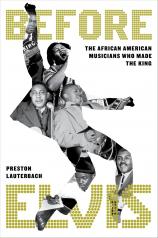Before Elvis: The African American Musicians Who Made the King
Review
Before Elvis: The African American Musicians Who Made the King
The author of six previous books centered on early Blues music and/or the music scene in Memphis, Preston Lauterbach seems uniquely qualified to take on the important subject of crediting the many musical influences that shaped the world into which Elvis Presley strode in the 1950s.
Lauterbach focuses primarily on the Black artists who helped create the kingdom of rhythm and blues in the late ’40s and early ’50s, leaving the many country music artists of those times for another discussion. His four key creators are Arthur “Big Boy” Crudup, credited for the most popular rendition of “That’s All Right, Mama” that became Elvis’ debut hit; Big Mama Thornton, whose sizzling “Hound Dog” in 1953 paved the way for Elvis’ monstrous #1 smash version in 1956; Little Junior Parker; and, as the wild card, the relatively obscure Memphis guitar innovator Calvin Newborn.
Tracing their respective career arcs in sometimes dizzying detail, Lauterbach builds his case for this foursome as the primary architects of the Memphis-and-beyond universe that shaped the young Elvis before he embarked on becoming a performer himself. In essence, we are given mini-biographies of each performer, with their triumphs and (sadly, more numerous) failures etched so vividly, based on what must have been an ocean of original research, including numerous interviews with surviving figures from those days.
"Fans of these wonderful innovators of early R&B always hunger for more knowledge about the origins of their creative process. Here, they are treated to a veritable feast."
How Lauterbach managed to unearth this treasure trove of information in all of its deep-dive specificity defies the imagination, but unearth it he did. While always revealing and generally fascinating, those hundreds of fine-tuned details do at times threaten to capsize the book’s focus. But most of the anecdotal history presented by Lauterbach does enrich our understanding of that essential period in the workings of the rising R&B industry, as well as its first transitions into what soon would be termed rock ‘n’ roll.
One of the most revealing sections of the book is the history of the song that now is primarily known as “Rocket 88,” which is often credited as being the first actual rock ‘n’ roll record. But here we learn of its complicated history, evolving from several earlier versions that were titled differently and performed by multiple artists --- some credited on the record labels, some not. (That’s one key spot where the mysterious Calvin Newborn comes in.)
A tangled web was also woven for the iconic song “That’s All Right, Mama,” which everyone knows as belonging to Arthur Crudup before Elvis covered it in 1954. Or is the correct term “appropriated” it? But Lauterbach expertly reveals that the song had a rich history long before “Big Boy” released his definitive version. And maybe Crudup did some appropriating of his own? It was all part of the fabric of how this music was made in those often chaotic times.
The book is also eye-opening in its revelations of how all of these artists --- big, medium and small in their relative levels of fame --- were exploited by their record labels. Yes, it’s an old story how even the greatest Black artists of that time who were paid pennies on the dollars were owed both for performance and song composition on their record sales. But here we learn that many times the pittance arrived on a royalty check that bounced. And even if it didn’t bounce, it often totaled only a few hundred dollars --- this for a record that might have sold hundreds of thousands of copies nationally. Accounting? Don’t make us laugh.
And what about the hundreds of times that the record companies failed to provide proper credit on the labels of the record, sometimes manufacturing spurious names for the actual performers out of whole cloth? The examples of this blatant wrongdoing provided in the book would be almost comical if they weren’t so horrifying.
Speaking of Big Mama Thornton, one of the book’s most delightful anecdotes has to be her 1966 meeting with Texas newbie Janis Joplin, a longtime admirer of the original version of “Hound Dog” (most of rock royalty by that time considered it to be superior to Elvis’ cover). Joplin asked permission to record a cover version of the epic song “Ball and Chain,” and Big Mama granted it --- asking only that she not screw it up. (We know that Joplin didn’t; it became one of her most iconic songs.) Simply picturing the two of them discussing this option in 1966 filled me with joy.
As for Elvis, the eventual beneficiary of so many of the fruits of R&B’s best and brightest, he prospered from that music in ways that Big Mama, Arthur Crudup, and so many others never could even dream of. But was there ever a figure more tragically exploited over the course of a career in rock music than The King himself? Doubtful.
Lauterbach’s thesis clearly is: It’s complicated. BEFORE ELVIS does a sterling job of educating us as to just HOW complicated it truly was. Fans of these wonderful innovators of early R&B always hunger for more knowledge about the origins of their creative process. Here, they are treated to a veritable feast. No wonder the back cover of the book bears a seal of approval from no less a figure than revered music historian Greil Marcus.
Reviewed by Michael Barson on April 26, 2025
Before Elvis: The African American Musicians Who Made the King
- Publication Date: January 7, 2025
- Genres: History, Music, Nonfiction
- Hardcover: 320 pages
- Publisher: Da Capo
- ISBN-10: 0306833085
- ISBN-13: 9780306833083



